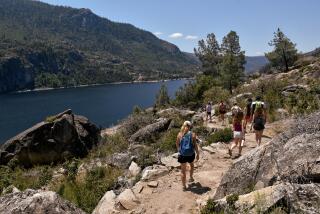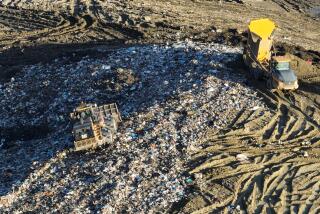TALKIN’ TRASH : Recycling Lessons Abound in ‘Garbage’ Exhibit at Children’s Museum at La Habra
Kids and trash go way back, but lately the relationship has changed.
As recently as a generation ago, trash was still legitimate entertainment. Fond memories were made at neighborhood dumpsters, where kids scavenged cool castoffs to play with.
Now with the increased public concern over the environment, aided by a wave of environmentally themed children’s books, toys and music, trash has become serious business. Ask almost any kid over 5 about the “three Rs,” and chances are he’ll snap back “Recycle, reduce, reuse.”
“Garbage . . . And All That Trash,” the latest exhibit at the Children’s Museum at La Habra, attempts to keep a foot in both camps. The touring exhibit, created by the Sacramento Science Center, is a mix of entertaining, hands-on activities and information. It continues through Sept. 11 in the museum’s changing gallery. The exhibit’s La Habra visit was underwritten by the California Integrated Waste Management Board.
“This is an exhibit that shows people how they can help solve the landfill problem by recycling, reusing and reducing waste,” said Pat McVicar, Sacramento Science Center administrative director.
“Garbage,” with its crawl-through imitation compost heap and piles of castoffs to sort, offers some distractions for younger children but is best suited to students in grades two through eight.
As visitors enter the gallery, they are greeted by a 6-foot-tall trash can in which children examine slide-out panels to discover what most people send curbside each week.
According to the display, every person in the United States generates four pounds of trash each day; it’s almost double that in California. Each panel in the display contains samples of the basic trash categories, and children are encouraged to apply recycling’s “three Rs” for ways they could help cut down on the family trash.
Overpackaging of consumer goods is responsible for much of the glut, the exhibit maintains. In the “Shopping for a Better Tomorrow” area, children can peruse a display of grocery store items, many of them packaged in recycled materials or in bulk sizes, and decide which would be the Earth-friendly choice.
Creators of the exhibit had some fun with this one. Intermixed with actual products are such phony items as Brain Grain cereal and Snott’s Juicy Paks.
Kids then run items over a supermarket-style scanner to find out if they’ve made the appropriate selection.
McVicar said Sacramento Science Center exhibits often cross disciplines. In several sections of “Garbage,” social studies shares the bill with environmental science.
The “Garbage in History” panels, for example, touch on the ways that past civilizations threw out their trash--mostly in the street. However, the exhibit tells us, when things started piling up so high that the street levels had to be raised to meet the layers of trash, ancient Greeks and Romans hit upon the idea of creating out-of-town dumps. At small tables scattered throughout the area, kids can examine samples of trash from this and other eras.
Even though “Garbage” is intended for children, the exhibit could open adult eyes, says the museum’s education curator, Carrie Wictor.
“The information here is stark enough to give adults a good bop over the head with an aluminum can,” Wictor says. “. . . People need to take responsibility for this right now.”
Six-year-old John Vanderschuit of Carlsbad agrees. After running his hands through a pile of real compost, John explained why he promotes recycling in his family.
“You have to use things over and over again,” he said, “ ‘cause if you just throw it out, then there’ll be too much of it. And that’s not good.”
More to Read
Sign up for Essential California
The most important California stories and recommendations in your inbox every morning.
You may occasionally receive promotional content from the Los Angeles Times.










